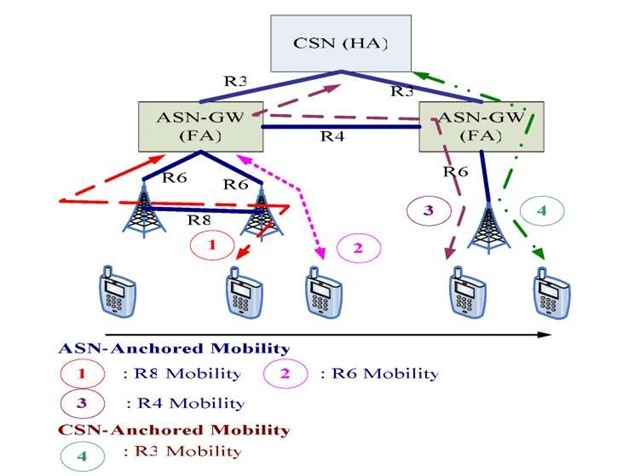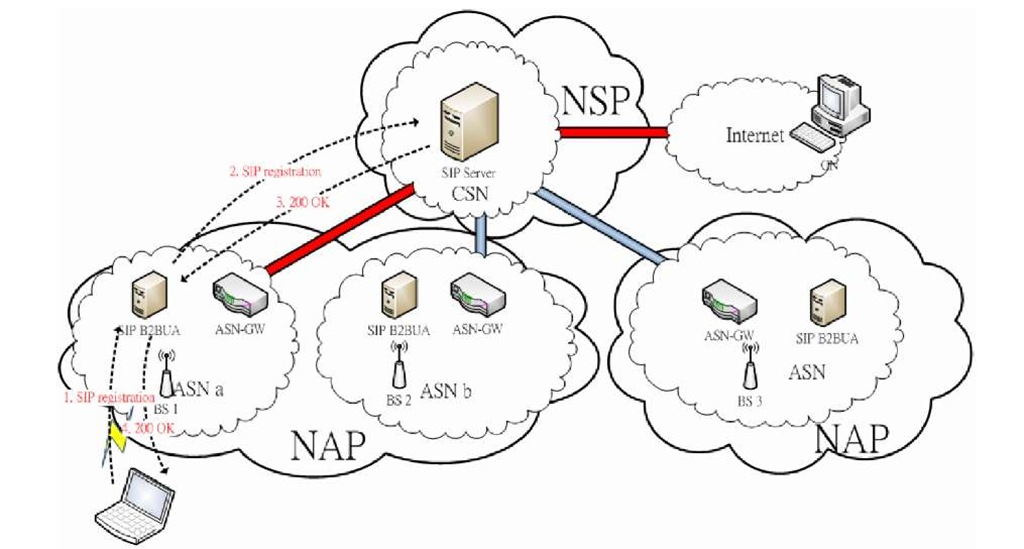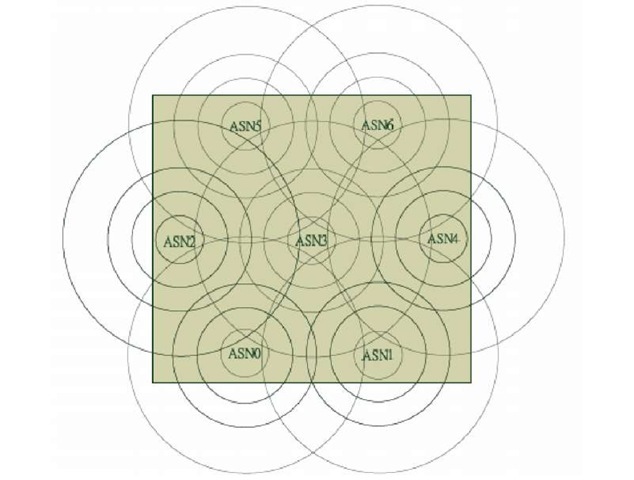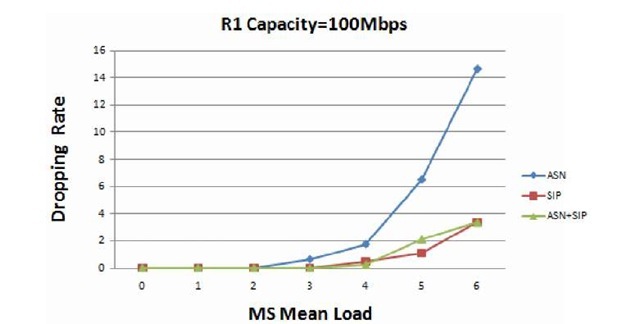Abstract
This paper studies cooperation of the ASN anchored mobility and SIP terminal mobility to improve the handoff performance in WiMax network. In addition to integrating the WiMax mobility and SIP mobility procedure by using the B2BUA concept, the proposed scheme investigates the traffic load so that the handoff dropping rate can be reduced. As the B2BUA acts as a proxy to handle the link layer and application layer handoffs, the handoff decision and policy can be performed through heuristic manner. Experimental simulations were performed and the results show that the proposed scheme can effectively utilize the traffic links to achieve the above objective.
Keywords: WiMax, Session Initiation Protocol, Mobile Network, Anchor Mobility.
Introduction
In recent years, new applications, such as Voice over IP (VoIP), Video on Demand (VoD), on line game, and Social Network Services (SNS), are continually developed to meet emerging service demands. These applications, when operate in mobile environment, need seamless handoff to achieve high quality service in practical wireless networks.
The Worldwide Interoperability for Microwave Access (WiMax) [1, 2] has been proposed to support broadband services in mobile environment. In order to provide complete end to end service scenario, the network is divided into access service network (ASN) and connectivity service network (CSN) with several control modules inside them to deal with the required signaling functions. The end to end architecture provides the ASN anchored mobility and the CSN anchored mobility for efficient handoff. The ASN anchor mobility keeps the path, which is prior to the anchor point, unchanged and, therefore, has smooth transmission performance and lower handover latency. However, the path between mobile node and CN may not be the optimal arrangement and may waste network resources. On the other hand, CSN anchor mobility is more efficient from the resource utilization point of view, however, the end to end path needs to be re-routed [3,4] and introduce longer handoff latency.
The WiMax Forum Network Working Group proposed the client based and proxy based Mobile IPv4 (MIPv4) and Mobile IPv6 (MIPv6) to cooperate with existing link layer mobility. However, the mobile node shall be equipped with mobile IP capability to retain the connectivity at network layer. Basically, it is not practical to assume that each mobile device could support mobile IP capability in real environment. Because the network layer function always tightly coupled with the software kernel in most mobile devices and it is not easy to be designed by most people. Therefore, providing handoff capability at application layer may be an alternative way to achieve it without changing network protocol. The Session Initiation Protocol (SIP) [5] is basically a user based mobility approach. The user identification, or alias, is the key to maintain the service connectivity and the IP mobility is not essential. By registering the current location (e.g. IP address) of the user identification at the SIP server, other user can easily query user location at the SIP server and communicate with user in a peer to peer manner. Furthermore, the re-invite procedure provides the user to inform user peer of location change during movement. However, as SIP is the application layer protocol, the SIP based mobility cannot improve the performance of latency and packet loss suffered from connection handoff [6, 7]. If using the soft handoff approach, which establishes the new connection before breaks the old connection, it is helpful to improve the performance of latency.
In this paper, we adopt the hybrid SIP and anchor based scheme as the basic concept for soft handoff and propose the back-to-back user agent (B2BUA) at ASN node, named as B2BUA-ASN node, as a proxy role to send invite and the re-invite message to CN to achieve handoff efficiently. A B2BUA is a logical network entity in SIP environment. It can receive the UAC message and use the Call Control Logic to transmit the other UA. The B2BUA can initiate the new call and modify the SIP message. Thus, the mobile node can be mobile IP unaware in the B2BUA-ASN node. In addition, as the ASN node also plays the role of anchor point for connection handover [8, 9, 10], the B2BUA-ASN node can consider the traffic condition to decide whether the handover connection is ASN anchored or not in a heuristic manner so that the network resource can be more effective utilized. This paper studies the operational scenario of B2BUA-ASN based on the existing WiMax handover procedure.
Overview of Mobility Management and Related Works
The mobility management is one of the important and critical issues in the wireless network environment. Because it covers several protocol layers and network interfaces. And the handoff performance is measured by several criteria. Generally, the handoff latency and packet loss during handoff are the performance indexes that are frequently analyzed. It is noted that the network load, including the network node and the link bandwidth, shall be considered in handoff. The WiMax forum defines a system wide architecture with several reference interfaces. And the layer 2, link layer, mobility has several scenarios and may occur at each reference interface as shown in Figure 1.
Fig. 1. WiMax Mobility Scenarios
In addition to the link layer handoff, the WiMAX end to end architecture documents [10, 11] also define the network layer mobility.
• Link Layer Mobility (CSN/ASN anchor)
In the WiMAX network architecture, it proposes two scopes of mobility. One is ASN anchored mobility and the other is CSN anchored mobility. ASN anchored mobility refers to a set of procedures associate with the movement between two BSs. The target BS can be in the same ASN or in a different one. The anchor ASN remains identical during ASN anchored mobility. ASN anchored mobility takes place when the MS moves to a neighboring BS that connects to a different ASN GW, which may be within the serving ASN or not. If the target BS belongs to a different ASN, the target ASN-GW will establish a R4 data path to the anchor ASN. Then the MS can avoid data loss and the QoS could be guaranteed as well. During the ASN anchored handoff procedure, the MS does not change its CoA. For ASN anchored mobility, traffic to the MS comes from the anchor ASN. CSN anchored mobility involves in anchor ASN relocation, which means anchor ASN is changed after CSN anchored mobility. After CSN anchored mobility execution, MS will update its CoA to the target ASN. The CoA renewal process uses Client MIPv4 (CMIPv4) or Client MIPv6 (CMIPv6) or Proxy MIPv4 (PMIPv4) protocol. And the network will trigger the data path function relocate so that the CSN will directly transmit the data to the target ASN. The Target ASN-GW is now become the anchor ASN-GW and serving ASN-GW to the MS. The procedure is known as R3 re-anchoring, because the traffic to MS comes from the new anchor point, which is a new R3 link. When CSN anchored mobility is executed, it is involved in CoA update. ASN Anchored Mobility prior to the CSN anchored mobility minimizes the handoff delay and packet loss.
• Network layer (CMIP, PMIP)
CMIP is used in the standard (RFC-3344) of the Mobile IP technology. The MN must support Mobile IP functionality. When MS discovered that they have moved, they will use the Mobile IP technology to update the network status. Proxy Mobile IP (PMIP) provides mobility support without change these devices network layer protocol. It is used in WiMAX, 3GPP and 3GPP2 architectures. PMIP network is the Network infrastructure help MN achieve the purpose of MIP. The MN doesn’t need to have the MIP ability, simply follow the original usage of the network (such as DHCP agreement), PMIP include a MAG (Mobility Access Gateway) into the Mobile IP architecture which interacts with the HA and the LMA (Local Mobility Anchor) is on behalf of the Mobile Node. MAG is an element on an access router that manages the mobility for a MS. LMA is the home agent for the MS in PMIP.
• Application Layer (SIP)
The SIP is an application-layer protocol, which is used in establishing and tearing down voice or video calls. SIP has high flexibility and high extension advantages. SIP supporting VoIP mobility is more important increasingly and supports four mobile Mechanisms:
1. Terminal mobility: Allow terminal device can move different domain or subnet. To ensure the packet can still deliver correctly, or the device can maintain the current participants of the session.
2. Session mobility: Allow the user switch to different terminal device during the SIP session, but the user is still able to maintain call quality keep the connection.
3. Personal mobility: Allow different terminal devices can use the same SIP address or a terminal device can use multiple SIP addresses at the same time. For Example: a SIP user can use one SIP URI to register the PC and mobile phone, users can only remember the URI.
4. Service mobility: Allows the user switches in different network, different network devices, different Internet service is still able to retain the original services.
The paper presented SIP mobility is Terminal Mobility. SIP (Terminal) Mobility Allow terminal device can move different domain or subnet. So the user can use the re-invite method to ensure the packet can still deliver correctly, or the device can maintain the current participants of the session.
Although, PMIP is the network-based approach to help MS achieve the purpose of IP mobility and the MS doesn’t need to have the MIP ability. But not all network infrastructures will support PMIP. It is depend on operator. When using the VoIP application, we must use the SIP to initialize communication and we find the SIP mobility is an application layer protocol. The advantage of SIP mobility is the network protocol of MS and network do not require any modification and it can be deployed on the network fast and easily. SIP register approach is similar to MIP approach. But in SIP register approach, the MS does not need fix HoA.
Consequently, we propose a combing the ASN, CSN Anchor and SIP Mobility and also builds the B2BUA component into the existing WiMAX architecture to overcome existing drawbacks.
The Proposed Hybrid SIP/Anchor Mobility Management Schemes
This paper proposes a hybrid architecture, which dynamically adopts SIP mobility through B2BUA and anchor mobility at the ASN component, to improve the handoff performance. When the MS powers on, it access WiMAX network and complete the ND&S (Network Discovery and Selection). Then the MS performs the Station Basic Capability (SBC) negotiation and authentication and notify the core network that MS support capability of SIP Mobility. We add two bits of the optional filed on extended capability [9] to specify whether the MS supports the SIP mobility and network assistant SIP mobility or not. After the completing the access authentication, the MS take the connection setup process. When the MS gets the IP address, then MS register to the SIP server. The MS can individually perform network layer mobility if it is equipped with CMIPv4 capability after the SIP connection is established as shown in Figure 2.
Fig. 2. Connection setup – SIP mobility (CMIP4)
In WiMAX Stage 2/3 definition, the core network can also support proxy mobile IP (PMIP) to assist the MS that has no mobile IP (MIP) capability. And both MSs of a SIP connection need MIP functions within the mobile environment if they want to be handoff at network layer. Alternatively, the SIP mobility provides the application layer mobility when the MS has no MIP capability. We propose to support the B2BUA function at the ASN component as shown in Figure 3. The B2BUA acts as a UA point of the correspondent node as well as a UA end point of the MS.
Fig. 3. Network assistance SIP mobility in WiMAX network with B2BUA
Without network layer capability, the MS will initiate SIP re-invite procedure when it moves to the other routing domain and receives a new IP address through the DHCP server. The MS is only notified of the new IP address, however, the network layer will not report the CoA to its correspondent node due to lack of MIP capability. Instead, the MS will send the re-invite message to its peer, i.e. the B2BUA, for the new IP address. As the layer 2 handoff shall occur when the routing domain changes. Therefore, the cross layer handoff decision will be considered at the ASN GW. Upon the receipt of the re-invite message, the ASN GW can either decide ASN anchor mobility without resend the re-invite message to the correspondent SIP client or resend the re-invite message to the correspondent SIP client for SIP mobility. If the ASN anchor mobility is taken, there will be no change at the correspondent SIP client, only the layer 2 handoff will occur between the moving MS and the ASN GW. In this case, the path between the correspondent SIP client and the previous ASN GW keeps the same and a tunneling data path will be established at R4 interface (i.e. between the previous ASN GW and the serving ASN GW). On the contrary, if SIP mobility is taken, the B2BUA at the serving ASN GW will send the re-invite message to the correspondent SIP client to report the new IP address. In this case, R3 interface mobility occurs and the tunneling data path is not necessary. Thus, the B2BUA has the flexibility to trade off the routing path during handoff.
The handover decision proposed in WiMax Stage 2/3 documents [11, 12] is to make the ASN Anchored Mobility first, and then the CSN Anchored Mobility. The reason is ASN Anchored Mobility doesn’t change IP, so it can complete the handover fast and reduce the handover latency. However, the ASN Anchored Mobility must establish the tunnel between previous (old) ASN-GW and the serving (new) ASN-GW. It increases the ASN-GW loading and the packet of tunnel overhead. If the MS moves far away the Anchor ASN-GW, it will cause a longer tunneling path and increase the transmission overhead. Regarding CSN Anchored Mobility (i.e. without tunneling path), its obvious advantage is to reduce the network resource as well as the load of ASN-GW. But the disadvantage is that the MS needs longer time to complete handover. The SIP Mobility is regarded as a kind of CSN anchor architecture, which is also named as R3 Re-anchor architecture.
In addition to the proposed B2BUA architecture, a load balance based handoff decision scheme is proposed in this paper. Generally, consider the downstream traffic, the arrival traffic of ASN GW may be either from R3 interface or the tunneled R4 interface. And as mentioned above, the load of R4 interface increases if the ASN anchor mobility is applied. Therefore, the decision of ASN anchor handoff or SIP mobility shall take the R3 and R4 load into consideration to achieve balance link load. Let a and be the thresholds of R3 interface and R4 interface loads, and x and y be the current loads measured by the serving ASN GW in R3 and R4, respectively. The link capacities of R3 and R4 are assumed as CR3 and CR4 . Then the proposed heuristic decision approach is as follows:
It is noted that the handoff connection will be dropped if there is no available bandwidth in R3 and R4 interfaces.
Experiments and Simulation Results
In order to evaluate the performance of the proposed scheme, exhaustive simulations were carried out. Our simulation topology is shown in Figure 4. The environment includes seven ASNs and every ASN has one ASN-GW and one BS. All ASN will connect to the Internet through the egress router.
The ASN profile B, which means the interfaces between ASN-GW and BS are a black box, was adopted in our simulations. Because we discuss the core network loading balance problem, we did not consider the R6 interface between the ASN-GW and BS in our simulations. We assume that each ASN-GW and ASN GW pair has separated R4 bandwidth. And the bandwidth of each R3 interface from each ASN-GW to the egress router is independent to each other. Figure 5 illustrates the arrangement of the above seven ASN-GW from top view. Every BS may adopt one of the four modulations, which are 64QAM, 16QAM, QPSK and BPSK, according to channel condition between MS and BS. In the neighborhood BS, every modulation has some overlaps. The MS may initiate handoff when it travels in this overlap area. The channel condition is assumed to be proportional to the distance between MS and BS and the modulation and coding scheme is dynamically adapted according to the channel condition as shown in Table 1. The MS is assumed to move according to the random way point mobility model in our simulations. The frame duration is 5ms.And the mobility related parameters are listed in Table 2.
Fig. 4. The simulation architecture
The simulation results of the proposed hybrid ASN+SIP scheme is compared with the drastic algorithm, which ignores the link loads and adopts either the ASN anchored Mobility (ASN only) or SIP Mobility (SIP only), to illustrate the performance of our approach.
Fig. 5. Top view of the simulation environment
Table 1. Modulation and BS coverage radius
|
Coverage Radius |
Inner circle |
Second circle |
Third circle |
Forth circle |
|
Modulation/Coding |
64QAM |
16QAM |
QPSK |
BPSK |
Table 2. Parameters of mobility model
|
Position |
Uniform Distribution |
|
Speed |
0 ~ 120Km/Hr Uniform Distribution |
|
Direction |
0 ~ 360 degree Uniform Distribution |
|
Halt time |
Exponential Distribution Mean value : 15 second Upper Bound : 30 second Lower Bound : 3 second |
|
Max Retry |
3 |
|
Retry Interval |
200ms |
|
Model |
Random Waypoint Mobility |
|
Threshold |
80% |
As mentioned in previous section, a handoff connection will be dropped if there is no available R3 or R4 bandwidth. However, the handoff connection will also be dropped if the bandwidth of R1 air interface is saturated. Therefore, we performed two experiments to verify the performance of the proposed scheme. In experiment 1, the bandwidth of R1 interface is assumed to be unlimited. This arrangement is to prevent the limited R1 capacity from affecting the dropping rate introduced by the insufficient R3 and R4 links. In experiment 2, the bandwidth of R1 interface is constrained, which is more comparative to the practical environment. The number of mobile stations is 100 in both experiments.
• Experiment!
The requested bandwidth of each MS is Gaussian distributed with various mean loads from 1 to 13Mbps, where the standard deviation is one. The bandwidth capacities of R3 and R4 are 200 Mbps and 15 Mbps, respectively. The values of a and are set to be 80% of the link capacity. As one ASN-GW connects to six ASN-GWs, the R4 of ASN-GW total bandwidth of ASN 3 is 90 Mbps. The simulation is illustrated in the Figure 6.
Figure 6 indicates that we the dropping rate of the ASN anchored mobility only scheme is the highest. The main reason is due to the limited bandwidth capacity in R4 interface. The SIP mobility only and the proposed ASN+SIP scheme have the similar dropping rate. Because the capacity of R3 interface is much larger than the R4 interface and the SIP mobility scheme always choose SIP mobility and, therefore, the dropping rate decreases. And the proposed scheme can dynamically choose R3 or R4 interface, its dropping rate is also lower accordingly.
Fig. 6. Experiment 1 simulation results (unlimited R1 bandwidth)
• Experiment 2:
In this experiment, we constrain the R1 interface capacity to be 100Mbps and the mean bandwidth of each MS requested varies from 1 to 6 Mbps. The main reason of reduce the mean load of each MS is due to the limited bandwidth in air interface. The other simulation parameters are the same as in experiment 1. The purpose of this experiment is to investigate whether the limitation on the R1 capacity affects the performance for those schemes or not. The simulation results of the three schemes are illustrated in the Figure 7.
Fig. 7. Experiment 2 simulation results (R1 bandwidth=100 Mbps)
Figure 7 shows that the dropping rate of the ASN only scheme still much higher than the SIP only and the proposed ASN+SIP schemes. Compared with Figure 6 for the mean load of 6 Mbps, the dropping rates of the SIP only and ASN+SIP schemes approach 0 in experiment 1 and it is about 3% in experiment 2. However, the dropping rate of ASN only scheme increases from 10% to 15%. It indicates that although the R1 capacity affects the dropping rate, however, the dropping rate will increase dramatically if the selection of R3 and R4 interfaces for the handoff connection is not properly considered.
It shall be indicated that although the SIP only and the proposed ASN+SIP schemes have the similar dropping rates for both experiments, it is clear that the handoff delay and packet loss rate of the proposed scheme shall be lower than the SIP only scheme. Because the ASN always needs to initiate re-invite procedure during handoff.
Conclusions
The paper studies the mobility scenarios in WiMax networks and proposes a feasible architecture to improve the mobility performance. There are two main contributions of this paper:
(1) Propose a B2BUA component in the WiMax architecture to achieve application layer mobility so that MS needs not to be equipped with mobile IP capability;
(2) The proposed hybrid scheme provides the flexibility for network resource arrangement so that the network resource can be evenly allocated.
The B2BUA in the WiMax network provides a proxy function to send re-invite message to the correspondent node. This approach reduces the transmission of packets in the air interface, therefore, the handoff latency and the loss of control message can be minimized. The simulation results also reflect the objectives of the proposed scheme. The parameters of a and adopts in this paper only consider the bandwidths of link capacity for the decision of handoff types. These two parameters and the interface selection (the decision handoff types) can be designed more sophisticated. Thus, the B2BUA may switch a connection with ASN anchor mobility to SIP mobility when the link utilization is too high even the layer 2 handoff does not occur. Owing to the B2BUA, more heuristic handoff consideration will be feasible and this is our on-going works.








